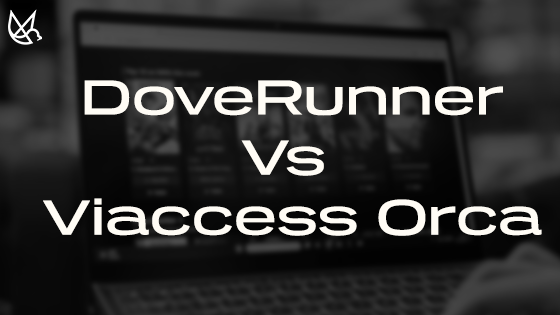The content security market is evolving rapidly, primarily due to the increasing sophistication of piracy threats. There are multiple players in the market who provide content security measures like DRM and anti-piracy technologies to deal with piracy threats. Different providers, for example, Viaccess Orca (VO) or Viaccess Orca competitors like DoveRunner, take different approaches in addressing security challenges for OTT platforms, broadcasters, and streaming providers.
Here is a comparison between Viaccess Orca and an alternative—DoveRunner. The comparison highlights key features, integration workflows, developer experience, and support models so you can choose the solution that best aligns with your content security needs.
Quick Comparison Summary: DoveRunner vs Viaccess Orca – Which One Should You Choose for Content Protection?
Both platforms deliver studio-grade content security, but their strengths differ. DoveRunner emphasizes SaaS agility and developer-friendly integration, while Viaccess Orca offers operator-grade trust and ecosystem depth.
Here’s a quick side-by-side comparison across critical security parameters:
| Feature | DoveRunner | Viaccess Orca |
| Multi-DRM Support | Cloud-based, unified license management across Widevine, PlayReady, FairPlay, Huawei WisePlay, and NCG. Supports hardware DRM (Widevine L1, PlayReady SL3000). | Supports major DRMs with a focus on operator-grade deployments. Strong device certification ecosystem. |
| Watermarking (Visible & Forensic) | Pre-integrated forensic watermarking, session-level, and distributor watermarking. Real-time detection and takedowns. | Advanced watermarking with session tracking is used widely by pay-TV operators. |
| Screen Recording Protection | Hardware DRM (L1), concurrent stream limiting, and Android-level screen recording prevention. | Device certification and trusted execution environments are emphasized, but screen recording prevention is less emphasized. |
| Monitoring & Takedowns | 24/7 global piracy monitoring, automated + manual DMCA takedowns, and piracy intelligence dashboards. | VO’s Eye on Piracy platform with global monitoring, enforcement, and intelligence reports. |
| Offline Playback Security | Supports Download-to-Rent (DTR) and Download-to-Own (DTO) with time tamper detection and white-box encryption. | Offline DRM playback is supported for major platforms, with a strong focus on operator devices. |
| Ease of Integration | SDKs for iOS, Android, tvOS, Windows, and OTT platforms. Simple APIs, proxy, or direct token authentication. | Deeper integration for telco-grade workflows, but it requires operator partnerships. |
| Deployment Options | Cloud-native SaaS, multi-region, scalable on AWS. Flexible API-based integration. | On-premise, hybrid, and cloud deployments are supported. Suited for large-scale operators. |
Comparison of Top Content Security Features:
When evaluating DRM and anti-piracy platforms, it’s important to look beyond basic encryption and assess how each solution can handle integration, scalability, and real-world piracy threats.
Below is a feature-by-feature comparison of DoveRunner and Viaccess Orca.
Multi-DRM Protection:
- DoveRunner – Unified DRM license service with central key management. Supports Widevine, PlayReady, FairPlay, WisePlay, and NCG. Hardware-level support for premium content with concurrent stream limiting and device blacklisting
- Viaccess Orca – Provides multi-DRM with operator device certification. Works closely with pay-TV ecosystems for deep device integration.
Watermarking:
- DoveRunner – Pre-integrated forensic and distributor watermarking. Session-level identifiers are resilient against re-encoding, filtering, and screen recording. Detection within minutes.
- Viaccess Orca – Viacess Orca features include session-based watermarking, embedded during delivery, integrated into VO’s anti-piracy platform.
Screen Recording & Piracy Prevention:
- DoveRunner – Widevine L1 and hardware DRM to block screen recording. Concurrent Stream Limiting (CSL) prevents account sharing. The analytics dashboard flags it as suspicious activity.
- Viaccess Orca – Leverages Trusted Execution Environments (TEE) and device certification to minimize piracy, but is less focused on direct anti-screen recording.
Global Reach & Scalability:
- DoveRunner – Cloud-native, AWS multi-region deployment ensures low-latency license delivery at scale. Suitable for global OTT services
- Viaccess Orca – Longstanding global presence with large operator clients. Proven track record in scaling pay-TV deployments.
Response to Piracy Incidents:
- DoveRunner – 24/7 monitoring across the web, torrents, and social media. Automated + manual takedowns. AI/ML-powered piracy detection coming soon
- Viaccess Orca – Eye on Piracy solution monitors and issues takedowns with a focus on operator-delivered content.
Advanced AI & Threat Detection Intelligence:
As piracy threats grow more complex, both platforms are enhancing their capabilities with data-driven insights and intelligent detection mechanisms.
DoveRunner Capabilities:
- AI/ML-driven piracy detection (roadmap) with real-time anomaly detection in DRM license requests.
- Analytics dashboard with user/device insights, error diagnostics, and suspicious activity detection.
- Automation-first approach with predictive blocking and blacklist management
Viaccess Orca Capabilities:
- VO’s data-driven piracy intelligence reports.
- Focus on large-scale operator piracy trends and intelligence sharing with content owners and regulators.
Comparing Security Features and Product Capabilities:
The effectiveness of a content security solution depends on how well it delivers encryption, watermarking, anti-screen recording, and scalability in real-world deployments.
Encryption Standards
- DoveRunner: Uses CENC, AES-128, and NCG encryption along with hardware DRM and License Cipher, which makes it much harder for hackers to extract keys.
Viaccess Orca: Follows industry-standard encryption with MovieLabs compliance, offering strong protection trusted by major operators.
Watermarking Techniques
- DoveRunner: Provides forensic and distributor watermarking that can survive edits, compression, or screen recording, with blind detection to trace leaks easily.
- Viaccess Orca: Focuses on forensic watermarking embedded directly at the stream level, making it effective for broadcasters managing large content libraries.
Anti-Screen Recording Measures
- DoveRunner: Blocks screen recording with hardware DRM like Widevine L1 and PlayReady SL3000, and can stop Android screen capture directly.
- Viaccess Orca: Relies on secure playback through device TEE environments, ensuring content can only run in trusted hardware zones.
Response to Incidents
- DoveRunner: Offers real-time piracy detection, automated DMCA takedowns, and detailed dashboards that give businesses live insights into threats.
- Viaccess Orca: Provides Eye on Piracy services, with strong monitoring tools aimed at protecting large broadcaster networks from illegal streaming.
Scalability:
- DoveRunner: Built on a cloud-native platform that can scale up or down easily, delivering licenses worldwide with low latency for smooth playback.
- Viaccess Orca: Trusted by global operators, offering flexible deployment options that work both on cloud and on-premise (hybrid setups).
Compliance & Certifications:
Industry certifications and compliance benchmarks ensure that DRM and anti-piracy solutions meet studio-grade security requirements and global content standards.
- DoveRunner: Certified by Cartesian Farncombe Security Audit™ and also meets studio security standards with a Movielabs compliant solution.
- Viaccess Orca: Broad compliance with MovieLabs, studio-grade certification.
Integration Workflow and Developer Experience:
The ease of integration and developer support can significantly impact how quickly and smoothly a security solution fits into existing OTT or operator workflows.
Integration Efforts:
- DoveRunner: Provides ready-to-use SDKs for iOS, Android, tvOS, Windows, and OTT platforms, making integration simple with minimal code changes. This helps startups and OTT platforms get up and running quickly.
- Viaccess Orca: Requires deeper, operator-level integration, which is ideal for large telecom or pay-TV companies but may feel heavy for smaller service providers.
Average Deployment Time:
- DoveRunner: Can be deployed within days to week, using cloud APIs, and offers a 1-month trial for proof-of-concept, making it fast to test and scale.
- Viaccess Orca: Deployment usually takes longer because of device certification and ecosystem dependencies, which are common in operator workflows.
Platform Compatibility:
- DoveRunner: Supports a wide range of platforms, including browsers, mobiles, Roku, FireTV, Tizen, and WebOS, giving flexibility across devices.
- Viaccess Orca: Works best with operator-certified devices and set-top boxes (STBs), making it strong in traditional broadcasting setups.
Flexibility & Customization:
- DoveRunner: Offers flexible APIs with options for proxy or direct token-based licensing, allowing services to adapt easily to their workflow.
- Viaccess Orca: Provides customization mainly within operator ecosystems, which limits flexibility for independent OTT providers.
Onboarding Support:
- DoveRunner: Makes onboarding easy with quick POC setups, clear documentation, and sample SDKs to guide developers.
- Viaccess Orca: Has structured onboarding designed for operators, which works well for broadcasters but can be complex for OTT startups.
Documentation & Developer Resources:
- DoveRunner: Developer-friendly with SDKs, sample codes, CLI packagers, and detailed API docs to speed up integration.
- Viaccess Orca: Documentation is enterprise-grade and detailed but focused mostly on operator deployments rather than developer-first setups.
Customer Support, Responsiveness & Service Experience:
- DoveRunner: Provides 24/7 global support, monitoring dashboards, and quick responses to piracy or technical issues.
- Viaccess Orca: Offers enterprise-level support for operators, but response cycles may follow operator processes rather than startup agility.
Training Sessions or Webinars:
- DoveRunner: Conducts workshops, training sessions, and POCs to help developers quickly understand and implement the platform.
- Viaccess Orca: Delivers structured training designed mainly for broadcasters and operators, fitting larger enterprise teams.
Onboarding & Setup:
- DoveRunner: Uses cloud trials and plug-and-play APIs, allowing for rapid setup without heavy infrastructure.
- Viaccess Orca: Involves more detailed onboarding for operator-grade clients, which may take longer but ensures deep integration.
Frequency of Updates & Security Patches
- DoveRunner: Regularly pushes SaaS updates with AI/ML-driven enhancements to stay ahead of piracy threats.
- Viaccess Orca: Provides reliable updates, but usually at slower cycles aligned with large operator releases.
Technical Expertise of the Support Team
- DoveRunner: Known for strong technical depth and responsiveness, with a team that listens to developer feedback.
- Viaccess Orca: Backed by decades of operator deployment experience, making them highly reliable for enterprise-grade projects.
Regional Support
- DoveRunner: Cloud-native with global reach and multi-region redundancy, ensuring stable service anywhere.
- Viaccess Orca: Strong presence in Europe, LATAM, and MEA due to deep telco and broadcaster partnerships.
Community Support
- DoveRunner: Building a developer-focused community with SDK resources, forums, and shared learning to help teams integrate faster.
- Viaccess Orca: More enterprise-driven and less community-facing, focusing on direct operator relationships rather than open developer ecosystems.
Conclusion: Choosing the Best Fit for Your Content Security Needs
While both solutions ensure premium-grade protection, each stands out with distinct strengths that cater to different types of providers and business models.
Unique Selling Points of DoveRunner:
- Cloud-native SaaS, quick deployment for OTT platforms.
- Pre-integrated forensic + distributor watermarking with real-time detection.
- AI/ML roadmap for piracy detection and analytics-driven insights.
- Developer-first approach with SDKs, APIs, and easy integration.
- Strong anti-screen recording features (Widevine L1, CSL, DRM Blacklists)
Unique Selling Points of Viaccess Orca:
- Decades of operator-grade deployments with global pay-TV clients.
- Strong device certification and trusted execution environment.
- Comprehensive Eye on Piracy platform with global enforcement.
- Studio-grade compliance with MovieLabs standards.
- Ideal for telcos, broadcasters, and hybrid operator OTT models.
Which One to Choose?
For OTT providers, ed-tech platforms, sports broadcasters, and live-streaming services looking for fast, flexible, and developer-friendly security – DoveRunner stands out as the more agile, SaaS-driven, and future-ready solution.
For large-scale operators, telcos, and pay-TV providers seeking deep integration with certified devices, robust compliance, and operator-grade workflows – Viaccess Orca remains a trusted, proven, and globally recognized leader.
Both solutions offer studio-grade protection, but your choice depends on whether you value speed + flexibility (DoveRunner) or operator ecosystem strength (Viaccess Orca).
Besides, DoveRunner provides a flexible pricing structure when compared to the Viaccess Orca price.
- DoveRunner is ideal for agile OTT services and digital-first platforms that prioritize quick rollout and easy scaling.
- Viaccess Orca, on the other hand, is best suited for enterprises that demand long-term stability, certified device control, and deep integration with existing operator networks.




